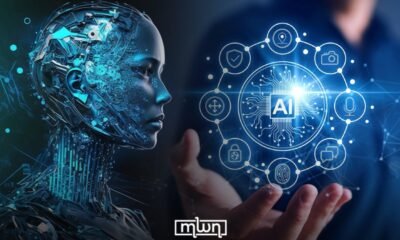AI Insights
Some Employees Are Pretending to Use AI—Report

Even as artificial intelligence grows in popularity, both in personal use and in the workplace to boost productivity, some employees are actually pretending to use AI, according to a new report from Howdy.com.
Roughly 16 percent of professionals sometimes pretend to use AI, according to the survey of more than 1,000 full-time workers.
Why It Matters
The rapid adoption of artificial intelligence systems is leading to major changes in how Americans interact with technology, information and everyday services.
As AI becomes increasingly integrated into web searches, workplace tasks and personal routines, data from multiple recent studies have indicated a sizable shift in user behavior, digital literacy and the broader impact on work and social structures.
However, as many workplaces begin to expect AI skills from workers, some employees may inevitably lag behind in skill adoption and pretend to use the tool in an attempt to appear more productive.
Cheng Xin/Getty Images
What To Know
In today’s workplace, 59 percent of workers report using AI at least daily, according to Howdy.com.
However, the onus may be falling on employees financially, as 56 percent admitted to paying out of their own pockets for more powerful AI tools at work.
Companies are also generally expecting AI use from workers, according to the report, as 75 percent said they are expected to use AI officially, and 22 percent said they feel pressured to use AI in situations they’re unsure about.
“Workers pretending to use AI is a symptom of modern micromanagement. Bosses want to see productivity, and AI has become the latest checkbox,” HR consultant Bryan Driscoll told Newsweek. “Employees fake it because they fear being judged as less competent if they don’t adopt it quickly, especially older workers, which could open companies to legal risks.”
This may lead to the 16 percent of professionals who say they have actually pretended to use AI at work.
“There’s a perception that AI adoption is synonymous with career security, and second, organizations often overestimate how seamlessly new technology fits into daily workflows,” Reza Hashemi, CEO and founder of Binj and ZEROin AI, told Newsweek. “Long term, if businesses don’t bridge the gap between hype and practical application, they risk creating a culture of fear and superficial adoption instead of true innovation.”
However, among those that do incorporate AI into their workflows, 72 percent said they were less burned out as a result, and 74 percent reported having less workplace stress.
What People Are Saying
Reza Hashemi, CEO and founder of Binj and ZEROin AI, told Newsweek: “Employees pretending to use AI is less about laziness and more about pressure. Many workers feel their value is tied to how quickly they adopt new tools, even if their company hasn’t given them the training, policies, or practical use cases to succeed with AI. In that gap, people ‘fake it’ to appear modern, efficient, and competitive.”
HR consultant Bryan Driscoll told Newsweek: “Long term, this obsession with appearances over outcomes erodes trust, deepens generational divides, and creates a workplace that values showmanship over actual results.”
What Happens Next
Companies that are able to help their employees use AI in an easy, understandable way will likely gain a competitive edge in the years to come, experts say.
“The companies that win with AI won’t just mandate its use, they’ll invest in making it understandable, safe, and genuinely useful,” Hashemi said. “That’s when employees stop pretending and start leveraging AI to unlock real productivity.”
AI Insights
How Artificial Intelligence is Redefining Business Process Automation

In today’s fast-paced economy, businesses are under constant pressure to operate more efficiently while reducing costs and improving customer experiences. Automation has long been a solution, but traditional methods such as simple scripts or rigid workflows often fall short in terms of adaptability and intelligence. This is where artificial intelligence comes into play. By partnering with an Artificial Intelligence Development Company, organizations can unlock new opportunities for smarter decision-making, streamlined operations, and scalable growth.
The growing interest in AI-driven automation reflects its role as a key enabler of digital transformation. Unlike conventional automation, AI systems can analyze large datasets, learn from patterns, and make predictions that allow businesses to stay competitive in increasingly dynamic markets.
Why AI for Business Process Automation
Traditional automation methods—such as scripts or Robotic Process Automation (RPA)—are useful for handling repetitive, rule-based tasks. However, they lack flexibility and cannot adapt to new or changing conditions without manual intervention. Artificial intelligence takes automation a step further by enabling systems to learn, adapt, and improve over time.
Through machine learning and advanced data analytics, AI can identify hidden patterns, make predictions, and support real-time decision-making. This makes it possible not only to automate processes but also to optimize them dynamically, driving more value than traditional approaches.
Key Areas of Application
Finance
AI enables faster and more secure payment processing, advanced transaction analysis, and fraud detection systems that continuously learn to recognize suspicious patterns.
Marketing and Sales
From demand forecasting and personalized customer experiences to intelligent chatbots, AI helps companies better understand their audience and increase conversion rates.
Manufacturing and Logistics
AI-powered tools streamline supply chain management, predict equipment maintenance needs, and reduce downtime, ensuring smoother operations and higher efficiency.
Human Resources (HR)
Recruitment processes are enhanced through automated resume screening, predictive analysis of employee retention, and data-driven insights for workforce planning.
Advantages of Implementation
The implementation of AI in business processes brings several clear advantages. One of the most significant is cost reduction: by automating repetitive, labor-intensive tasks, companies can cut manual rework and optimize resource allocation, which lowers operating expenses without sacrificing quality. AI also accelerates processes, as models are capable of handling large data streams in near real time.
This speed translates into faster approvals, more efficient routing, more accurate forecasting, and quicker customer responses, all of which shorten cycle times. Another key benefit is error minimization. With advanced pattern recognition and anomaly detection, AI reduces human error, ensures data consistency, and helps stabilize performance metrics across workflows.
Finally, AI offers unmatched flexibility and scalability. Systems continuously learn from new data, allowing them to adapt to changing rules and business volumes, while cloud-native deployments make it possible to scale operations seamlessly as demand increases.
Potential Challenges
Despite these benefits, businesses face certain challenges when adopting AI automation. Costs and timelines are among the first hurdles. The discovery phase, data preparation, model training, and integration require significant upfront investment, and success often depends on a phased delivery approach to manage risk.
Data quality is another critical factor. If the available data is incomplete, biased, or siloed, the outcomes will inevitably suffer. Strong governance, robust cleaning pipelines, and continuous monitoring are necessary to maintain reliable results. Ethical and legal considerations must also be addressed.
Organizations need to ensure that their AI solutions operate with transparency, fairness, and respect for privacy, while remaining fully compliant with regulatory standards and internal policies.
Conclusion
AI-driven automation is now a core lever of competitiveness, improving speed, accuracy, and margins while enabling adaptive operations. Start small, pick a high-impact process, validate with a pilot, then scale iteratively with robust data governance and clear ROI checkpoints.
Do You Want to Know More?
AI Insights
Local Events | coastsidenews.com

We recognize you are attempting to access this website from a country belonging to the European Economic Area (EEA) including the EU which
enforces the General Data Protection Regulation (GDPR) and therefore access cannot be granted at this time.
For any issues, contact customerservice@coastsidenews.com or call (650) 726-4424.
AI Insights
Here’s what parents need to know about artificial intelligence

ChatGPT, AI chatbots, and the growing world of artificial intelligence: it’s another conversation parents may not have planned on having with their kids.
A new Harvard study found that half of all young adults have already used AI, and younger kids are quickly joining in.
Karl Ernsberger, a former high school teacher turned AI entrepreneur, says that’s not necessarily a bad thing.
“It is here to stay. It’s like people trying to resist the Industrial Revolution,” Ernsberger said.
Ernsberger believes tools like chatbots can be powerful for learning, but only if kids and parents know the limits.
One example is “Rudi the Red Panda,” a virtual character available for free in kids mode on X’s Grok AI. When asked, Rudi can even answer questions about Arizona history.
GROK
“The five C’s of Arizona are Copper, Cotton, Cattle, Citrus, Climate,” Rudi said.
But Ernsberger warns that children may struggle to understand that Rudi isn’t real, and that “friendship” with a chatbot is different from human connection.
“It’s hard for the student to actually develop a real friendship,” he said. “They get confused by that because friendship is something they continue to learn about as they get older.”
When asked if Rudi was really my best friend, it replied: “I’m as real as a red panda can be in your imagination. I’m here to be your best friend.”
That, Ernsberger says, is where parents need to step in.
For families trying to keep kids safe while exploring AI, Ernsberger’s first recommendation is simple.
“Use it yourself. There are so many use cases, so many different things that can be done with AI. Just finding a familiarity with it can help you find the weaknesses for your case, and its weaknesses for your kids.”
Then he says if your child is using AI, be there with them to watch over and keep the human connection.
“The key thing with AI is it’s challenging our ability to connect with each other, that’s a different kind of challenge to society than any other tool we’ve built in the past,” Ernsberger said.
Regulators are paying attention, too.
Arizona Attorney General Kris Mayes, along with 43 other state attorneys general, recently sent a letter to 12 AI companies, including the maker of Rudi, demanding stronger safeguards to protect young users.
-
Tools & Platforms3 weeks ago
Building Trust in Military AI Starts with Opening the Black Box – War on the Rocks
-

 Business2 days ago
Business2 days agoThe Guardian view on Trump and the Fed: independence is no substitute for accountability | Editorial
-

 Ethics & Policy1 month ago
Ethics & Policy1 month agoSDAIA Supports Saudi Arabia’s Leadership in Shaping Global AI Ethics, Policy, and Research – وكالة الأنباء السعودية
-

 Events & Conferences3 months ago
Events & Conferences3 months agoJourney to 1000 models: Scaling Instagram’s recommendation system
-

 Jobs & Careers2 months ago
Jobs & Careers2 months agoMumbai-based Perplexity Alternative Has 60k+ Users Without Funding
-

 Funding & Business2 months ago
Funding & Business2 months agoKayak and Expedia race to build AI travel agents that turn social posts into itineraries
-

 Education2 months ago
Education2 months agoVEX Robotics launches AI-powered classroom robotics system
-

 Podcasts & Talks2 months ago
Podcasts & Talks2 months agoHappy 4th of July! 🎆 Made with Veo 3 in Gemini
-

 Podcasts & Talks2 months ago
Podcasts & Talks2 months agoOpenAI 🤝 @teamganassi
-

 Mergers & Acquisitions2 months ago
Mergers & Acquisitions2 months agoDonald Trump suggests US government review subsidies to Elon Musk’s companies






















